Expert’s Rating
Pros
- Resolution of 1440 x 1440 pixels (1:1 aspect ratio)
- 150- x 150-degree field of view shows visitors from head to toe
- Runs on battery or wired power
- Priced right, especially when it’s on sale
Cons
- Subscription required for important features, including video recording
- Doorbell must be detached from its mount to charge its battery
- Incompatible with Apple Home and Google Home ecosystems
Our Verdict
The Ring Battery Doorbell would be a much better option for the budget-minded if it wasn’t so tied to a subscription plan. On the other hand, it’s a great choice for those who are already in the Ring home security ecosystem and paying for a sub, and are looking to add an inexpensive doorbell—especially for secondary doors.
Price When Reviewed
This value will show the geolocated pricing text for product undefined
Best Pricing Today
Best Prices Today: Ring Battery Doorbell (2024 release)

$59.99
Ring offers one of the best smart home security ecosystems on the market, encompassing everything from security cameras and video doorbells to indoor and outdoor lighting, sensors, and professionally monitored home security systems. The flexible Ring Battery Doorbell, introduced late last year, makes for a great introduction to that ecosystem.
But that recommendation comes with a caveat: You’ll need to sign up for a Ring Home subscription if you want to unlock all this product’s features—and that includes the ability to record video. Without one, you’ll receive notifications when someone rings your doorbell, but you’ll only be able to get a live view of what’s happening in front of its camera.
I’m going to assume you know that already, so I’ll explain how much those subscriptions cost and what they include until later. First, let’s discuss the Ring Battery Doorbell’s features and performance.
The Ring Battery Doorbell is a good first step into the Ring home security ecosystem, which requires a paid subscription of one form or another to deliver maximum value.
Specifications
- Dimensions: 4.98 x 2.44 x 0.91 inches (HxWxD) (6.19 x 2.30 x 12.65 cm)
- Build materials: Primarily plastic
- Camera resolution: 1440 x 1440 pixels (1:1 aspect ratio)
- Camera field of view: 150 degrees horizontal x 150 degrees vertical
- Color night vision
- Audio: 2-way, with noise cancellation
- Wi-Fi: 2.4GHz only
- Operating conditions: -4 degrees Fahrenheit to 122F (-20 to 50 degrees C)
- Power options: Non-removable rechargeable battery, or a conventional doorbell transformer and low-voltage wiring (8-24 VAC, 40VA max, 50/60Hz)
Design and feature set
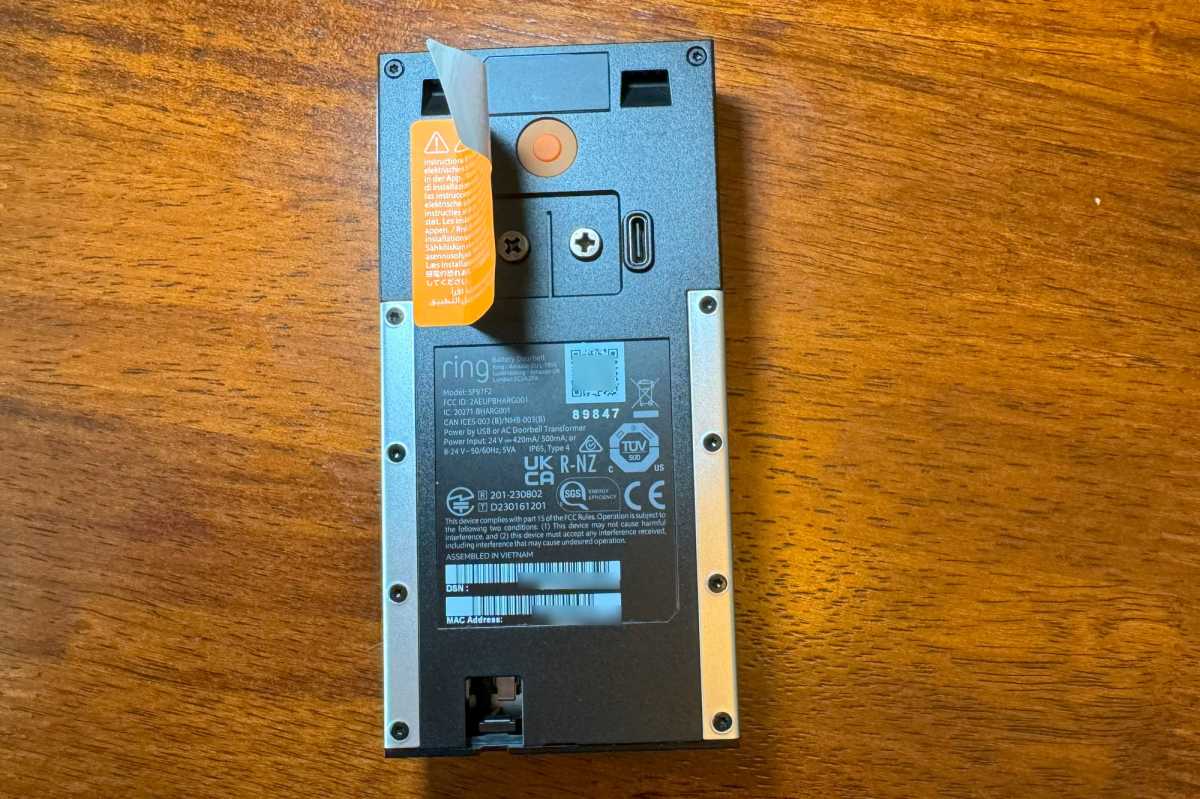
Despite its name, the Ring Battery Doorbell can run on either battery or hardwired low-voltage power if you have an existing transformer.
Michael Brown/Foundry
Ring’s least expensive video doorbell replaces the Ring Video Doorbell (2nd Generation) we reviewed in September 2020. It carries a suggested retail price of $99.99, but it was discounted to just $59.99 at the time of this review. That low street price puts it in the realm of many bargain-priced doorbells with far fewer features. That said, you’ll still need to accept some compromises. Chief among these is the fact that you’ll need to remove the doorbell from its mount to charge its battery—if, that is, you’re running it on battery power.
Unlike some battery-powered door-priced doorbells, you can opt to connect the Ring Doorbell Battery to a conventional doorbell transformer using low-voltage wiring (8-24 volts AC, 40VA max, 50/60Hz). Power it that way, and its onboard battery will automatically kick in should your home experience a power outage. I went with the battery option and found the doorbell exceedingly easy to install and configure. The Ring app steps you through the entire process and provides helpful tips along the way. Be aware that if you need to offset the doorbell’s viewing angle with a wedge because of your home’s siding, you’ll need to purchase that accessory separately.
This review is part of TechHive’s in-depth coverage of the best video doorbells.
The doorbell measures 4.98 x 2.44 x 0.91 inches (HxWxD), dimensions that are generally unremarkable apart from the distance it sticks out from your wall. It’s available in your choice of two colors: satin nickel or Venetian bronze, but don’t let those metallic descriptions fool you, the device is nearly entirely fabricated from plastic—as those of its ilk tend to be.
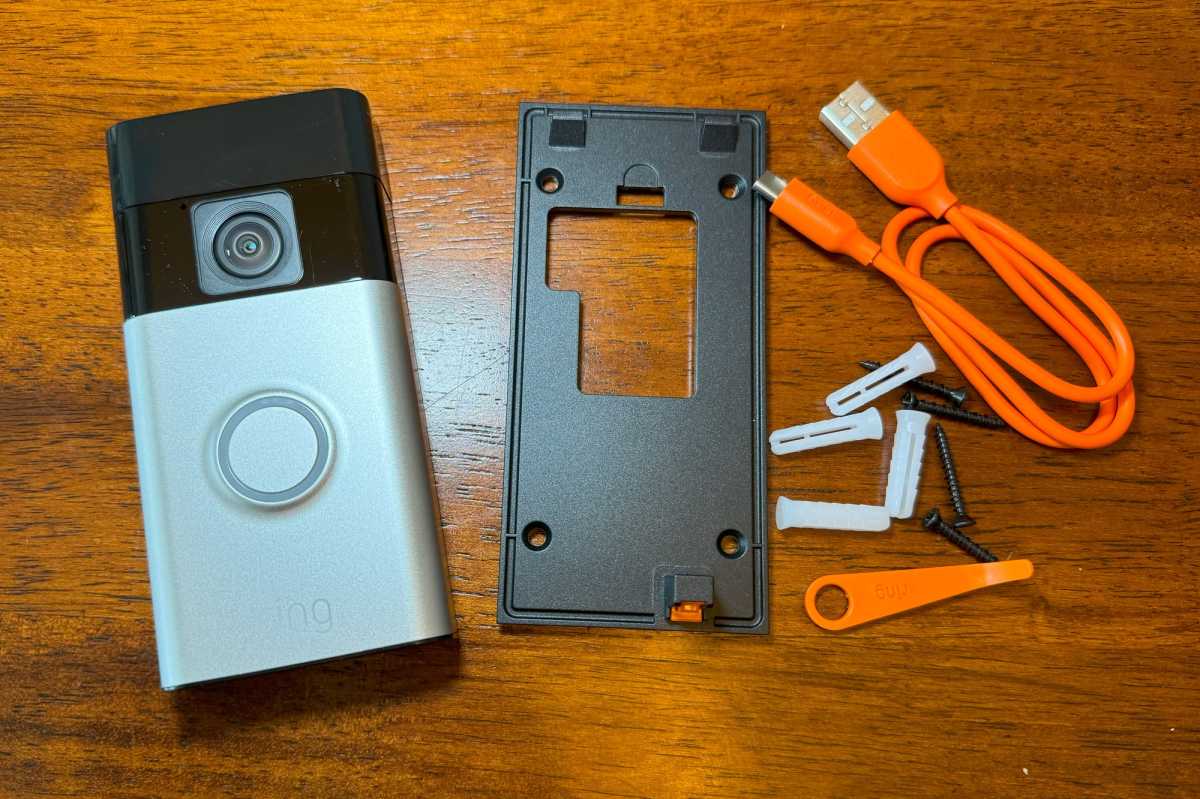
The Ring Battery Doorbell comes with a simple mounting plate and the screws needed to secure it, a USB-A-to-USB-C cable for charging its battery, and a tool for detaching it from its mount when you need to charge its battery.
Michael Brown/Foundry
The Ring Battery Doorbell’s face is dominated by a microphone and camera lens above a doorbell button, the latter of which is surrounded by an LED light ring that glows blue and spins when a visitor pushes the button. A chime inside the doorbell will also sound, but in the absence of other Ring or Amazon products, the only place you’ll get a notification is on your smartphone.
Enable Ring’s Doorbell Calls feature (subscription required) and the doorbell will call your smartphone so you can see and speak with your visitor. Or if you’d rather, enabling Ring’s Smart Reponses feature will have the doorbell automatically play a pre-recorded message when someone presses the doorbell button. This option, which also requires a subscription, also allows your visitor to leave their own message for you.
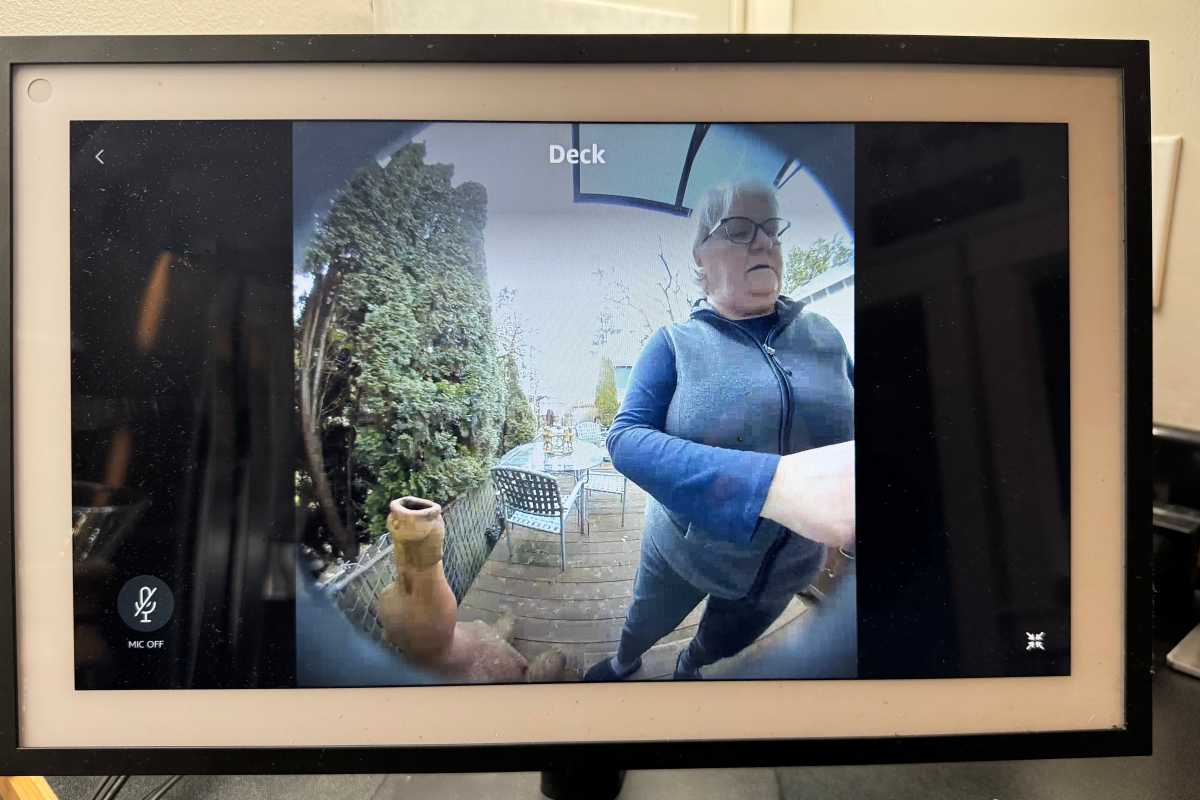
When your visitor presses the Ring Battery Doorbell, you can see them and have a conversation on one of Amazon’s smart displays, such as the Amazon Echo Show 15 shown here.
Michael Brown/Foundry
You can purchase a Ring Chime ($35) that you’ll plug into an AC outlet inside your home, and that device will also sound off when the doorbell detects motion or someone rings its bell. The step-up Ring Chime Pro ($60) adds an onboard nightlight and a dual-band Wi-Fi range extender to the mix. Note that many budget-priced video doorbells include this type of accessory in the price of the doorbell itself.
If you have one or more Amazon Echo smart speakers or displays in your home, those devices are even more useful than either Chime model. They’ll make the same announcements, and Amazon Show smart displays will automatically switch to a view from the camera to show your visitor. Should you choose, you can initiate a conversation with that person using either an Echo Show or your smartphone (with the latter offering that benefit even if you’re away from home).
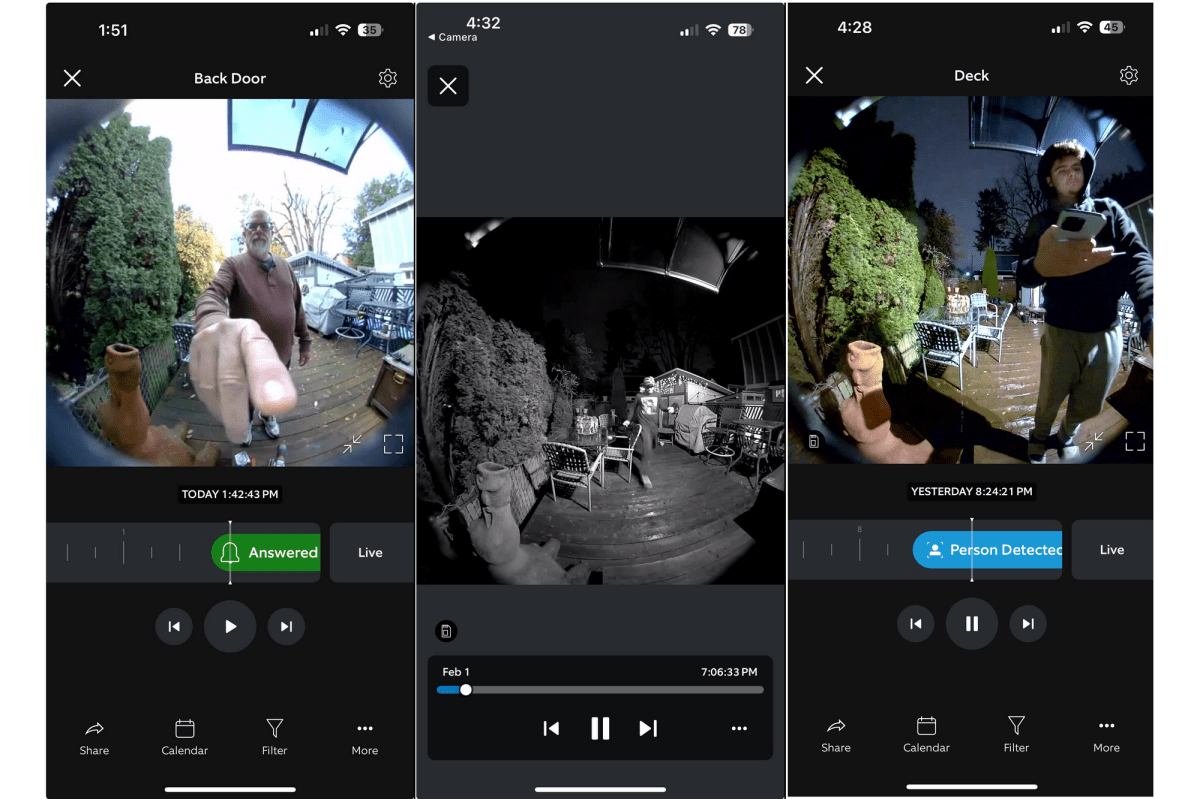
The Ring Battery Doorbell captures your visitors in crisp and well-saturated color, including at night with the aid of porch light. Infrared B&W video looks great, too.
Michael Brown/Foundry
While you can integrate the Ring Battery Doorbell into an IFTTT setup, it is not compatible with Google Home, and it can’t be integrated into the Apple Home ecosystem, either.
You can add up to three irregularly shaped motion detection zones, and the doorbell will ignore motion that occurs outside those zones. You can use these zones to prevent swaying trees or shrubs in view of the doorbell camera from triggering unwanted motion alerts or recordings. You can also add up to two square or rectangular privacy zones to block the camera from streaming or recording video. This is useful for ensuring your neighbor’s privacy by blocking views of their doors, windows, gates, or walkways.
Ring Battery Doorbell performance
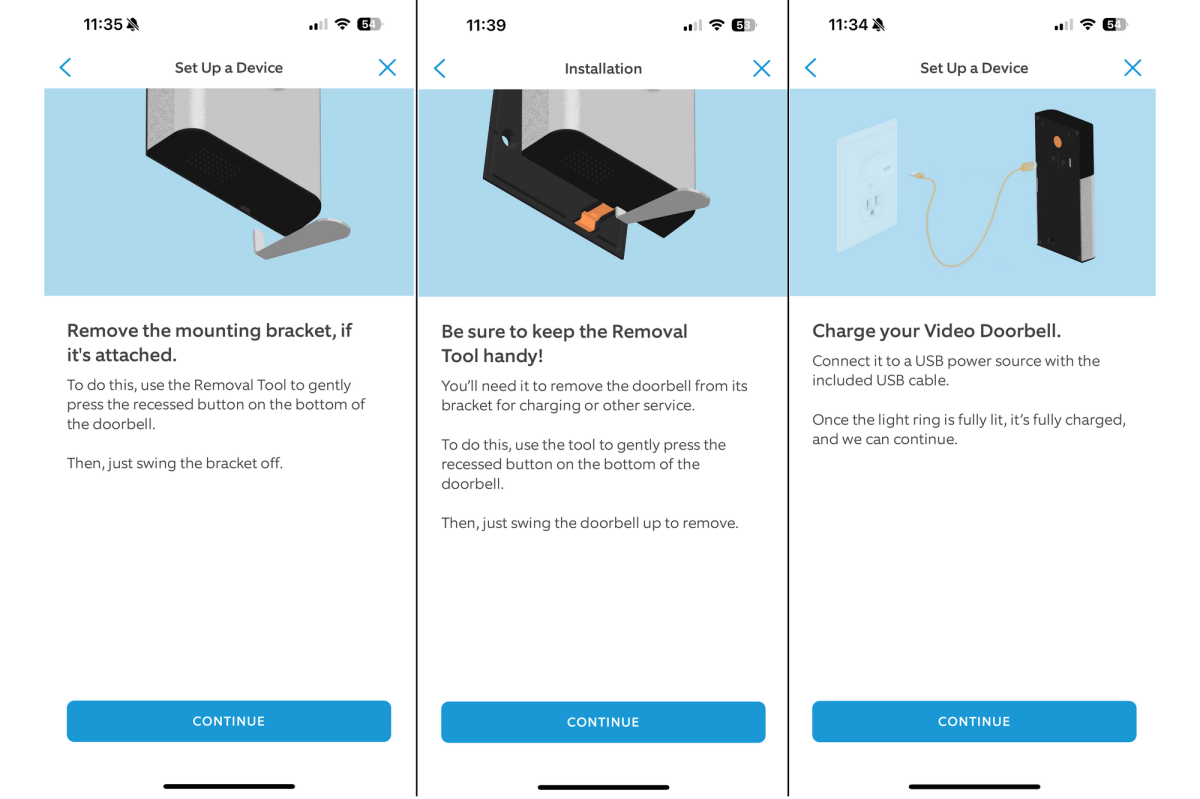
You’ll need to detach the Ring Battery Doorbell to charge its battery, so don’t lose the tool provided for that purpose.
Michael Brown/Foundry
Videos are captured with a 1:1 aspect ratio at a respectable resolution of 1440 x 1440 pixels. The camera’s 150-degree horizontal by 150-degree vertical field of view provides head-to-toe views of your visitors. There is very little barrel distortion in live and recorded video, and you should be able to see packages left at your doorstep—provided you install the device at the recommended distance of 4-feet above the surface of your porch. If you want notifications of packages left at your door, you’ll need one of Ring’s subscriptions.
Black-and-white infrared night vision is also excellent, but full-color night vision—which must be enabled int the app—was a bit washed out. You’ll get better results with the aid of outdoor lighting, such as from a porch light. And this is one of the areas where Ring’s comprehensive ecosystem delivers a significant benefit. I mounted the Battery Doorbell next to the door leading to my backyard deck, where I’d previously installed a wired Ring Floodlight. The motion detector on that device senses anyone coming up the stairs to the deck and turns its lights on sooner than the doorbell does, so the doorbell’s camera is able to catch anyone approaching in full color.
And if you have other Ring devices deployed around your home, you can link them all together and program them to trigger each other according to their capabilities: Other cameras can record, other lights can turn on, and so on, no matter where they’re physically installed. By the same token, you can program other Ring devices to trigger this doorbell camera to record even if it doesn’t sense motion. As such, you can get a complete view of everything happening in and around your home if you have enough Ring cameras and lighting devices up and running.
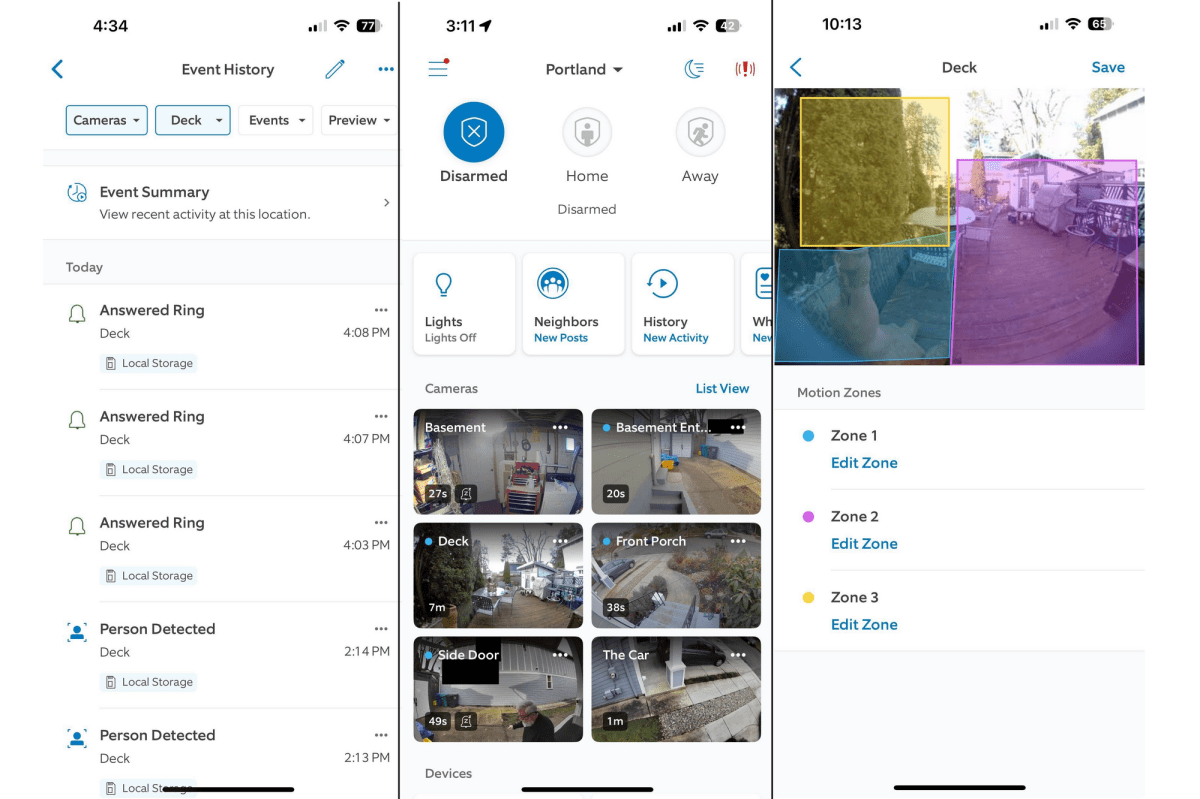
The Ring app maintains detailed activity logs for each device. You can view thumbnail images from all your cameras arrayed in either a grid, as shown in the middle screenshot, or as a list. The right-hand screenshot shows motion-detection zones.
Michael Brown/Foundry
Ring isn’t the only manufacturer to offer both security cameras and smart lighting—Anker’s Eufy Security is one of the companies looking to close that gap—but Eufy does not yet have a whole-home security system to compete with the Ring Alarm or Ring Alarm Pro systems that offer the option of professional monitoring. Speaking of which, you can store video recordings locally if you plug a microSD card into a Ring Alarm Pro system, but that still requires a subscription. Unlike some other video doorbells, the Ring Battery Doorbell doesn’t have its own microSD card slot for local storage.
Needing to dismount the entire doorbell to recharge its battery is a bit of a drag—the USB-C port for this is on the back of the doorbell—and you won’t want to lose track of the plastic tool Ring provides for that purpose. On the bright side, the battery should last for several months between charges, and the Ring app provides plenty of advance notice when it does.
About those Ring Home subscriptions
Ring retooled its subscription service plans in October 2024, resulting in significant price increases for many of its customers who wanted to keep the same basket of services. As before, Ring offers three tiers of service, but adding professional monitoring that has humans monitor your Ring security system and dispatch first responders in the event of a break-in, fire, or medical emergency now entails an add-on fee of $9.99 per month.
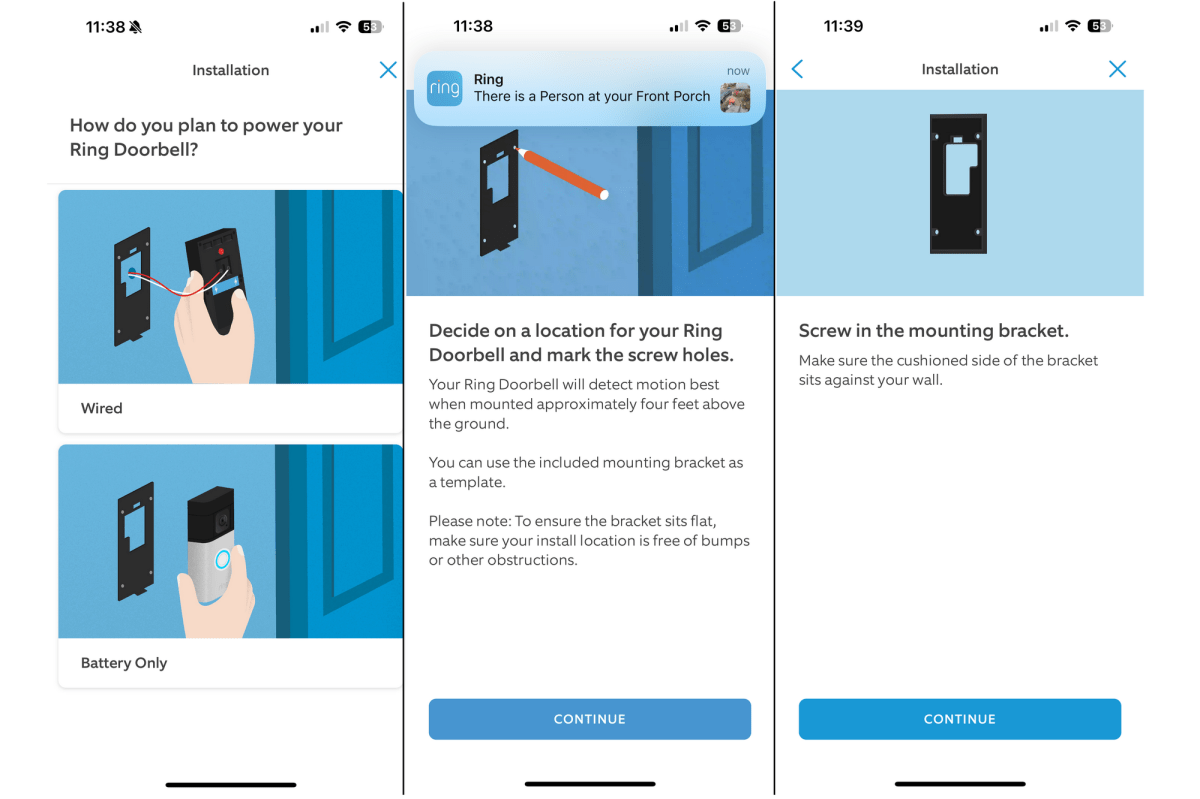
No manufacturer walks you through the installation process better than Ring.
Michael Brown/Foundry
Ring Home Basic costs $5/month ($50/year), and it’s all you need to get person and package alerts along with video recordings and cloud storage for your Ring Battery Doorbell, but it covers only one Ring video doorbell or camera, and it does not include the Doorbell Calls feature. To get that, or if you have more than one device and you want to unlock the full feature set on all of them, you’ll need to step to at least a Ring Home Standard plan. This tier costs $10/month ($100/year) and it covers as many Ring video doorbells and Ring security cameras as you own. It also unlocks the Doorbell Calls feature and enables backup broadband service for Ring Alarm and Ring Alarm Pro systems.
If you own a Ring Alarm or Ring Alarm Pro system, you’ll want to sign up for a Ring Home Premium subscription at $20/month ($200/year). This service includes all the features in the two lower tiers, and it adds a 24/7 recording feature for a short list of wired Ring security cameras, AI-powered Smart Video Search, and SOS Emergency Response that lets you summon immediate police, fire, or medical assistance to your location by pushing a button in the Ring app.
As I’ve already mentioned, professional monitoring for a Ring Alarm or Ring Alarm Pro now costs $10 per month in addition to any of the other three subscription tiers.
Should you buy a Ring Battery Doorbell?
The Ring Battery Doorbell is an above-average entry-level home security device and a good first step into the Ring home security ecosystem. But it depends on a subscription to unlock all its features. If you’re already paying for one, it’s a great choice for a less-frequently used entry point, such as a side or back door. For your front door, you should also take a look the Ring Battery Doorbell Plus (street priced at $150), which delivers higher video resolution, a removable battery, and other features.
If you’re shopping for your first video doorbell and you don’t want to be tied to a subscription, there are plenty of other battery-powered options, starting with the Blink Video Doorbell (street-priced at just $35, including the Blink Sync Module 2 required for local storage and live streaming on demand), or as a step-up, the Tapo D225 Video Doorbell (street priced at $80).




